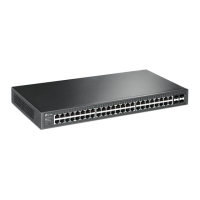42
Chapter 7 Etherchannel Commands
Etherchannel Commands are used to configure LAG and LACP function.
LAG (Link Aggregation Group) is to combine a number of ports together to make a single
high-bandwidth data path, which can highly extend the bandwidth. The bandwidth of the LAG is
the sum of bandwidth of its member port.
LACP (Link Aggregation Control Protocol) is defined in IEEE802.3ad and enables the dynamic
link aggregation and disaggregation by exchanging LACP packets with its partner. The switch
can dynamically group similarly configured ports into a single logical link, which will highly
extend the bandwidth and flexibly balance the load.
7.1 channel-group
Description
The channel-group command is used to add a port to the EtherChannel
Group and configure its mode. To delete the port from the EtherChannel
Group, please use no channel-group command.
Syntax
channel-group
num
mode { on | active | passive }
no channel-group
Parameter
num
—— The number of the EtherChannel Group, ranging from 1 to 6.
on —— Enable the static LAG.
active —— Enable the active LACP mode.
passive —— Enable the passive LACP mode.
Command Mode
Interface Configuration Mode (interface gigabitEthernet / interface range
gigabitEthernet)
Privilege Requirement
Only Admin, Operator and Power User level users have access to these
commands.

